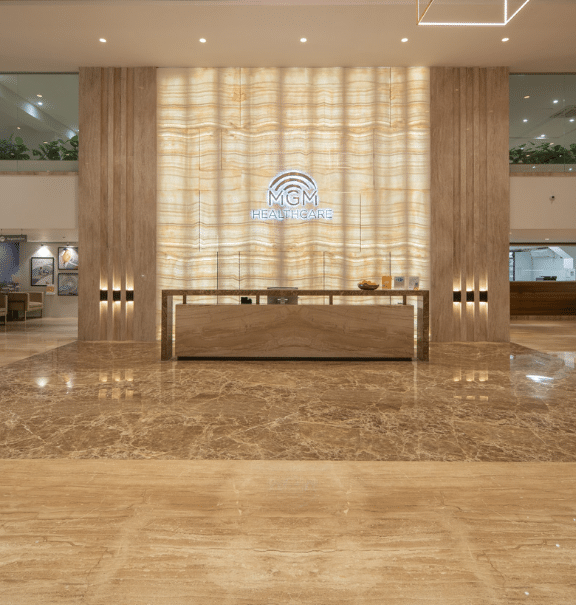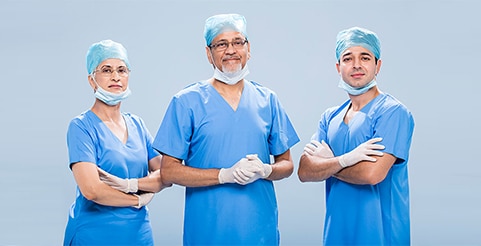What is reconstructive plastic surgery?
Reconstructive plastic surgery is generally done to correct facial and body abnormalities caused by birth defects, injury, disease, or aging. The aim of reconstructive plastic surgery is to improve body function. However, reconstructive plastic surgery may also be done to create a more normal appearance and improve self-esteem (and hence is also called as cosmetic surgery). Abnormal structures of the body may result from injury, infection, developmental abnormalities in-utero, birth defects, diseases and tumours.
Who are candidates for reconstructive plastic surgery?
There are two types of people who require plastic or reconstructive surgery.
- People with birth defects like craniofacial anomalies, cleft lip, deformities of the limbs, etc.
- People with deformities due to an accident, disease, infection or due to ageing.
What types of plastic surgeries are done at MGM Healthcare?
Breast Surgery
- Mammoplasty or breast surgery is done on women who seek surgery to improve their body shape. Mammoplasty procedure include breast augmentation or breast enlargement, breast reduction and breast lift also known as Mastopexy.
- In some male, there is enlargement of the mammary tissue and this condition is known as Gynecomastia. Male breast reduction may be done by liposuction or with various scar patterns, often hidden around the nipple and areola.
Liposuction
- If there is large amount of fat in various parts of the body like abdomen, thighs, buttocks, hips, backs of the arms, and neck, liposuction, or suction-assisted lipectomy can be done to vacuum the fat using thin cannulas, or hollow metal tubes. Liposuction may also be used for male breast reduction.
Vulvovaginal surgery
- Vaginoplasty procedure include labiaplasty, labia minor reduction, or labial reduction and involves surgery of the labia majora or labia minora of the vulva, a part of the female genitalia.
Body procedures
- When there is excess fat in the middle or lower region of the abdomen, abdominoplasty or tummy tuck is done to tighten the muscles and fascia of the abdominal wall thereby reshaping and firming the abdomen.
Other body contouring procedures
- Buttock augmentation to make the buttock appear larger thereby enhances the appearance of the buttocks. This can be done by grafting fat from another part of the patient’s body using liposuction. This is known as the Brazilian Butt lift. Alternatively, silicone implants may also occasionally be used in the buttocks.
- In some cases, a buttock lift is required to remove excess skin from the hips, buttocks, and thighs in order to tighten and lift them.
Facial cosmetic surgery
- In Blepharoplasty, eyelid surgery is done to reshape the eyelids.
- In Rhinoplasty, the patient’s nose is reshaped to improve the appearance and often breathing, too.
- In Otoplasty, or ear surgery, prominent or misshapen ears is treated by surgically pinning the ear closer to the head with sutures, reshaping the cartilage, or both.
- In Rhytidectomy, also known as a facelift, wrinkles are surgically removed and facial skin is tightened to bring a more youthful appearance
- In Broplasty, also known as forehead lift, raised drooping eyebrows, forehead wrinkles or worry lines are removed alongside other cosmetic procedures to achieve a more harmonious facial appearance.
- Chin augmentation is done to make the chin more prominent and provide a better balance of facial features.
- Malar, or cheek, augmentation is done to make the cheekbones more prominent.
Peels, fillers, grafts, and laser treatment
- Chemical peels may help treat acne, pock marks, scars, or wrinkles.
- Botulinum toxin, or Botox, is approved for treatment of frown lines on the forehead, crow’s feet, or lines around the eye, and axillary hyperhidrosis, or increased sweating of the armpits.
- Soft tissue fillers, or dermal fillers, are medical device used in helping to create a smoother, fuller appearance in the face.
Hair transplantation
- This surgery can return hair growth to those with hair loss.
Reconstructive surgeries we do
The most common birth defects, cleft lip and cleft palate are openings or splits in the upper lip, the roof of the mouth (palate) or both. Cleft lip and cleft palate result when developing facial structures
don’t close completely during foetal development. Both the conditions can be corrected surgically that can help restore normal function and achieve a more normal appearance with minimal scarring.
How is it performed?
- Before the start of the surgery, general anaesthesia is administered to the child.
- To repair a cleft lip, incisions are made on either side of the cleft to create flaps of skin, muscle and intraoral tissue.
- These are then drawn together and stitched to close the cleft and recreate the anatomy of the upper and nose.
- The repair of a cleft palate requires careful repositioning of tissue and muscles to close the cleft and rebuild the roof of the mouth. Incisions are made on either side of the cleft and specialised flap techniques are used to reposition the tissues of the hard and soft palate.
- The repair is then stitched closed, generally along the midline of the roof of the mouth, providing enough length of the palate to allow for normal feeding, speech development and continued growth throughout life.
- Once the cleft lip and/or cleft palate have been repaired, the incisions can be closed with removable or absorbable sutures.
- Over time, the scars fade and are often barely visible.
Craniosynostosis is a birth defect in which one or more of the fibrous joints between the bones of a baby’s skull (cranial sutures) close prematurely (fuse), before the baby’s brain is fully formed.
Brain growth continues, giving the head a misshapen appearance. Treating craniosynostosis involves surgery to correct the shape of the head and allow for normal brain growth.
How is it performed?
- Open surgery
- Before the surgery starts, general anaesthesia is administered.
- An incision is made over the top of the head, from just above one ear to just above the other ear.
- A flap of skin, tissue and muscle below the skin, and the tissue covering the bone are loosened and raised up so the surgeon can see the bone.
- A strip of bone is usually removed where two sutures connect. This is called a strip craniectomy.
- Sometimes, bones that are left in place need to be shifted or moved and sometimes, the bones around the eyes are cut and reshaped.
- Bones are fastened using small plates with screws.
- Surgery usually takes 3 to 7 hours.
- Minimally-invasive surgery
- A newer kind of surgery is used for some children.
- The surgeon makes one or two small cuts in the scalp, usually above the area where the bone needs to be removed.
- The endoscope is passed through the small cuts. The scope allows the surgeon to view the area being operated on.
- Using special instruments, the surgeon removes portions of bone through these cuts.
- This surgery usually takes about 1 hour.
- Most children need to wear a special helmet to protect their head for a period of time after surgery.
Skin grafting is a surgical procedure that involves removing skin from one area of the body and transplanting it to a different area of the body. This surgery may be done if a part of the body has lost its protective covering of skin due to burns, injury or illness. There are two basic types of skin grafts: split-thickness and full-thickness grafts.
A split-thickness graft involves removing the top layer of the skin as well as a portion of the deeper layer of the skin. Such grafts are usually harvested from the front or outer thigh, abdomen, buttocks or back. A full-thickness graft involves removing all of the epidermis and dermis from the donor site. These are usually taken from the abdomen, groin or forearm. Full-thickness grafts are generally used for small wounds on highly visible parts of the body, such as the face.
How is it performed?
- Before the start of the surgery, the patient is given general anaesthesia.
- The surgeon begins by removing skin from the donor site.
- Once skin is removed, the surgeon carefully places it over the transplant area and secures it with a surgical dressing, staples or stitches.
- The doctor also covers the donor area with a dressing that will cover the wound without sticking to it.
- Post-surgery, the patient’s vital signs are monitored and pain medication is given. The patient may be required to stay in the hospital for a few days to ensure proper healing.
- The graft should start developing blood vessels and connecting to the skin around it within 36 hours. The donor site will heal within one to two weeks, but the graft site will take a bit longer to heal.

 In-person Consultation
In-person Consultation Online Video Consultation
Online Video Consultation Treatment Enquiries
Treatment Enquiries Find a Doctor
Find a Doctor Access the Patient Portal
Access the Patient Portal +91 44 4524 2424
+91 44 4524 2424  Anaesthesiology & SICU
Anaesthesiology & SICU Total Knee replacement
Total Knee replacement







